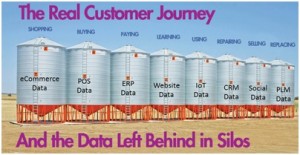Getting Lost Between the Silos

image credit: Magic Software Enterprises
Many companies have the goal of gaining a 360-degree view of their customer interactions. However, ERP users who have integrated CRM data to see the full picture think they have reached the summit only to discover that there are still further hills to climb.
Customer interactions are defined by more than just the CRM system. Transactions are sometimes processed in eCommerce, point-of-sale systems and even mobile order-entry apps. Work orders may be handled by field service, PLM (product lifecycle management) and other systems. Shipments to customers are tracked with warehouse management, transportation management and logistics systems. There is no shortage of business applications, cloud services and social media sites that touch your customers.
So how do you truly achieve a 360-degree customer solution? First of all it’s important to clarify why you want a full customer view. It’s not only about getting a 360-degree view of data, but also to capture a 360-degree view of the entire customer experience. The goal is to use all of the integrated data to surround customers with a quality experience that satisfies and delights them so they become raving fans.
Don’t integrate customer data, optimize the customer experience
Focusing only on data integration can tell you what happened, usually only a day later. As a result, your sales, marketing and service teams may make bad decisions based on day old batch information. It’s likely that your customers will not be impressed if when servicing them you have outdated and incomplete information. Making sure there is up to date information that is near real time that is relevant to each step of the customer journey is essential for successful system integration.
McKinsey & Company as well as other leading researchers suggest that companies need to embed customer journeys into their operating models in four ways: (1) they must identify the journeys in which they need to excel, (2) understand how they are currently performing in each, (3) build cross-functional processes to redesign and support those journeys, and (4) institute cultural change and continuous improvement to sustain the initiatives at scale.
As you seek to identify the key parts of the journey, the areas where excelling above the competition will cause your enterprise to thrive, you need to look at all of the processes, as well as the various systems that interact with them, and to analyze the improvements that can be made.
The various systems that manage different aspects of the functional processes don’t need to change radically. However, what does need to change is your ability to analyze data across the different systems, and most importantly to trigger processes between the systems. Building a real-time customer architecture to support customer experiences means spanning multiple systems with triggers, alerts, alarms and escalations. This means you need a system integration solution that does more than just data integration, you need one that handles real-time business process orchestration as well.
Keeping customer focus at every step
An integration effort must be made to improve overall organizational efficiency and bridge the gap between the systems, with the goal of optimizing each stop along each individual customer journey. In addition to creating unnecessary work, process gaps cause tangible business risk. Suffering through these gaps causes organizations to be susceptible to human error; experience slower response times; sustain increased process costs; and suffer deteriorating employee satisfaction.
Integrating ERP and CRM systems is not just about collecting all the data, but also about streamlining customer service, order processing, and sales administration. To avoid black holes in the customer journey, all of the various IT systems related to all steps along the customer journey: shopping, buying, delivering and servicing customers, must be connected. Instead of simply integrating CRM and ERP data, automating customer facing processes across IT systems is the best way to improve and optimization the customer experience.



